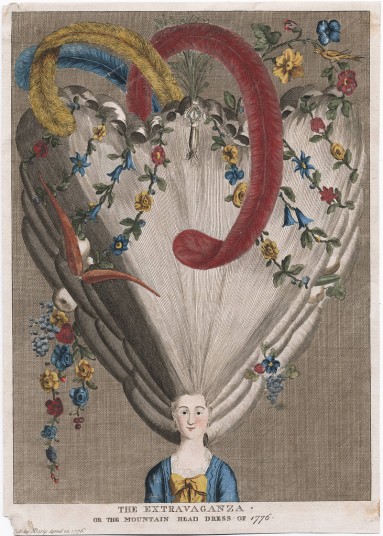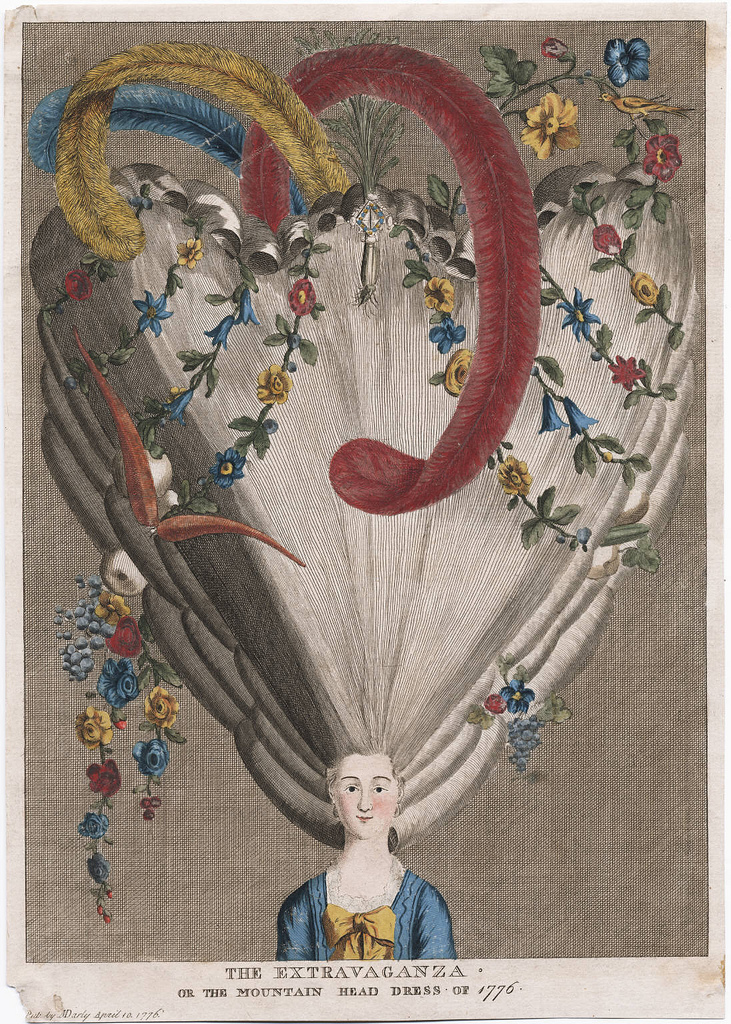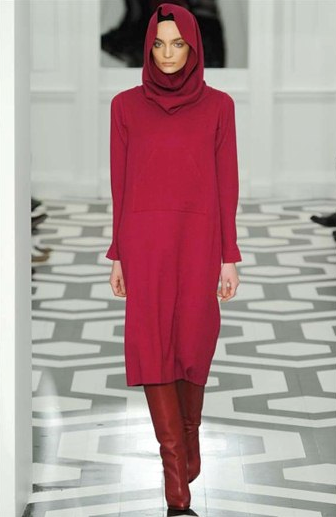What's going on in beauty this week, from head to toe and everything in between.

From Head...
The extravaganza: Seems that we've always liked to mock vanity, and there's none better than Sissydude's hilarious collection of antique images satirizing elaborate hairstyles of yore. (via Final Fashion)
Celebrate good times?: Mark Black History Month—with a sale on hair relaxers! Oh my. To be sure, hair relaxers have a place in black history; plenty of black women straighten their hair and they're not race traitors because of it. But couldn't Family Dollar have come up with a better way to celebrate Black History Month? Like changing their name for the month to Family Fifty-Eight Cents to mark the continuing pay disparity between black and white Americans? (Actually, I now see this was from two years ago. But the misguided idea here is unfortunately persistent, as this updated roundup shows.)
...To Toe...
I cannot believe this isn't more popular: Shoe stores offering pedicures.
...And Everything In Between:
Bad week for makeup makers: L'Oréal is closing a Cleveland-area plant because it's consolidating its shampoo and conditioner manufacturing, putting 260 out of work. And Proctor & Gamble is laying off and otherwise reducing work for several thousand employees making up 3% of its workforce. Counterintuitively, given the company's successful marketing campaigns, much of the reduction is coming from marketing and other non-manufacturing departments.
Video star: I admit I don't really get the Lana Del Rey thing, meaning I understand neither the vitriol directed in her direction nor the passionate defenses of her—rather, I don't understand why her music has spurred such discourse. That said, the discourse is interesting, particularly this piece at Tiger Beatdown: "[D]udes are angry because they have been exposed to the artifice; because seeing Lana del Rey perform, they cannot claim that there is such a thing as a 'unique natural femininity.' They hate her, of course, because to acknowledge the artifice would, inevitably, lead to questioning the artifice behind their own notions of femininity and, again, inevitably, their own stereotypes of masculinity." I just sort of wish her music was as interesting as what people are saying about it. (I do like her music, for the record; I just don't how it's sparked this kind of discussion. Then again, I never understand music lyrics, ever, so maybe that's why she's lost on me? She could be singing in Cambodian for all I know.)
Does this include Mary Janes?: What we buy when we purchase a named garment (like J.Crew's Minnie pants): "The emotional structure of a proper name sparks a relationship with pants that transcends the physical interactions that would normally occur in a store. Verbal and iconic structures confirm the pants are real, but the emotional structure connotes a person-to-person exchange. Online, the Named garment allows us to establish trusting relationships with products through action that simulates clicking personal profiles, rather than transactions devoid of humanity. That sweater? She’s Tippi. Those shoes? Mona."
Ladyscience: Science writer Hillary Rosner's piece about her frustration on writing for women's magazines shows what goes on behind the scenes. I'm similarly frustrated by women's magazines and know what she says to be absolutely true (that is, I've never worked with Rosner but have seen this happen repeatedly in my career)—but I'm also a believer in what they've done for women, and what they can continue to do. Women's magazines were instrumental in women's health issues being taken seriously, and they do a good job of staying on-point with service for the reader. It's that very service—the single-minded aspiration to give readers a singular "takeaway"—that drives many of the problems Rosner is writing about here. We need the takeaway, but we also need credible science writing in women's magazines if they're to continue giving true service to women.
Cupcakes and cash: Cupcakes and Cashmere blogger Emily Schuman is signing on with Estee Lauder as social media editor, which makes sense, as she's "our ideal customer," according to the brand global president. It's an example of the crucial role of authenticity in brand marketing: Schuman has a loyal readership because they see her as speaking solely for herself, and by teaming up with Estee Lauder, that quality is transferred. (Also, and this is pure conjecture, hiring Schuman is probably cheaper than their usual promotional venues, which would make Wall Street happy instead of frowny over Estee Lauder's middling earnings.)
Beauty at All Ages!: e.l.f. Cosmetics is having a downright revolutionary contest called "Beauty at All Ages," in which aspiring models can enter pictures of themselves in one of four categories: teens, 20s, 30s, and 40+. All ages, people, you hear that? All ages.
Oh Nicki: Clutch magazine casts a critical eye upon Nicki Minaj's embrace of the white beauty standard. "The fact that Minaj has generated so much success by merging the typical mainstream beauty standards of Barbie and Marilyn Monroe with the outlandish 'ghetto booty' that so many black men celebrate speaks volumes."
On stand-ins: Maryam Monalisa Gharavi on the use of imagery in one of the most absurd news stories of late: the public use of a cardboard cutout of Ayatollah Ruhollah Khomeini to mark the anniversary of his post-exile return to Iran. "He who denounced immodestly dressed women as ‘coquettes’ (the Shah referred to them as ‘dolls’) has been dwarfed into a string puppet. ... I find myself more interested in what is really real in these photos than what constitutes simulacra of the real." It's an interesting story in its own right, but while reading I kept thinking: We can easily see the use of a cardboard cutout of Khomeini as patently ludicrous. But it's also an (admittedly dramatic) externalization of the way we do treat images as the real deal—worth keeping in mind with image-worship of beautiful women.
Haute hijab: Terrifically excited to see where Underwraps, a new Muslim modeling agency, goes.
The Chinese consumer: The state of cosmetics in China. Makeup was forbidden under the Cultural Revolution, paving the way for cosmetics education seminars targeting new consumers, including a "lunch and learn" program for administrative office workers.
Blue Ivy™: Did Jay-Z and Beyonce actually file a trademark claim on their daughter's name, with the intent of using it for a line of beauty products?
Beauty Imagined: My reading list is a gazillion miles long, but this Bookslut review of Beauty Imagined: A Global History of the Beauty Industry bumps Geoffrey Jones's book farther up the list.
Gone raw: I feel pretty strongly that a raw-foods diet is way too close for comfort to eating-disorder-land, but if anyone could convince me otherwise it's Gena and her textured writings at Choosing Raw. And this piece about the dangers of pursuing a raw or vegan lifestyle as a beauty regime shows why. "There is a ton of pressure for people who eat healthy to also look 'the part.' It is assumed that healthy vegans and vegetarians will be slim, clear-skinned, and energetic at all times. ... I’ve been approached by readers when I was particularly exhausted before, and gotten worried: did I look pale? Did I have bags under my eyes? Obviously, those things indicate nothing more than the fact that I’m a full time pre-med student and blogger who doesn’t sleep enough. But the fear is that people will assume my healthy lifestyle habits are ineffectual, or a hoax."
"Appearance sports": Plenty of us are well-versed in spotting the signs of eating disorders. But this piece focuses on symptoms of eating disorders in female bodybuilders, whose symptoms may be less easily spotted because A) being thin isn't the point, and B) attention to physique is already a given in their lives.
"Repetition is the uniform": Brittany Julious, lyrical as ever, has a short prose piece "On Uniforms."
Also, owl tattoos: The Blind Hem looks at the "functionless fashion" of hipsters. "So instead of uselessly consuming the useless, as the readers of Vogue are wont to do, the readers of Vice consume—still uselessly—the useful. Hipsters pervert the traditional functionlessness of aesthetic objects by taking up, as fashionable, clothing that has as its only redeeming quality function (Carharts, Doc Martins, flannel, etc)... All this appears to constitute the kind of perversion that makes the non-hipster media not only uncomfortable but angry."
Dulce de leche: Breastfeeding glamour, courtesy Nahida at The Fatal Feminist.
Bellies up: Danielle at Final Fashion looks at the fetishized belly throughout history, from Venus of Willendorf to Christina Aguilera. (The day I read this, I purchased my first-ever empire-waist item, a long aquamarine nightgown. Coincidence? I think not.)
Also, she's all of 53: Two differing but ultimately compatible takes on the issue of Madonna and age, spurred by her Superbowl halftime performance. Caitlin proposes a moratorium on jokes about her age, while Julie Klausner and Natasha Vargas-Cooper at The Awl ask why she insists on clinging to a girlish version of sexiness instead of a womanly version of it.
Let's get comfortable: Decoding Dress, with her ever-sharp critical eye, examines a fashion double bind: In part I, she presents the question of dressing stylishly versus dressing comfortably, and in part II, she breaks down the role societal authority has in both creating and enforcing the double bind.
Extra/ordinary: On eating disorders and the desire to be extraordinary. I don't agree with everything this piece says (and I got the feeling throughout that the writer hadn't quite liberated herself from the need to feel extraordinary, but then again, who has?). But it's a good look into the links between "impostor syndrome," eating disorders, and achievement. So many ED stories focus on the "need to be thin" from an appearance-based perspective, and I particularly like that this doesn't do that, preferring to look at that drive from the more complex place where eating disorders are actually born.


